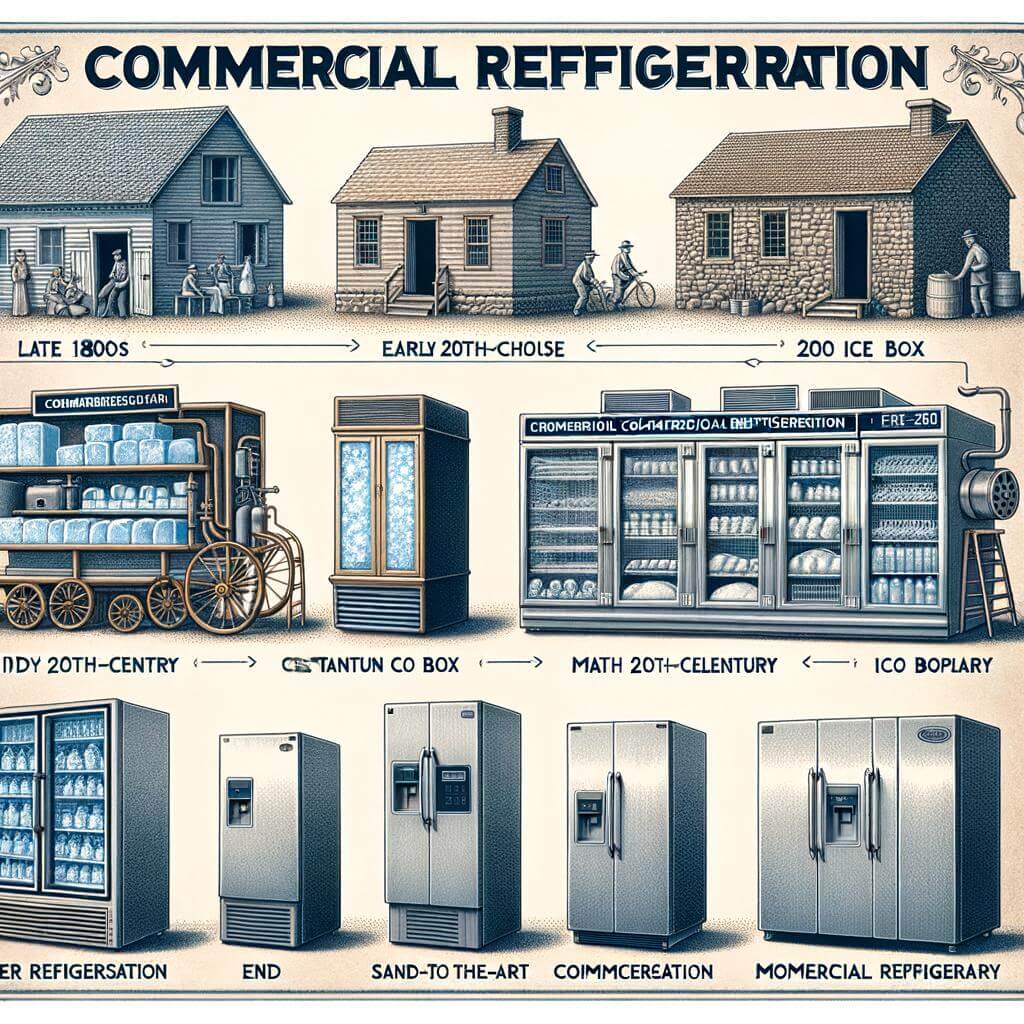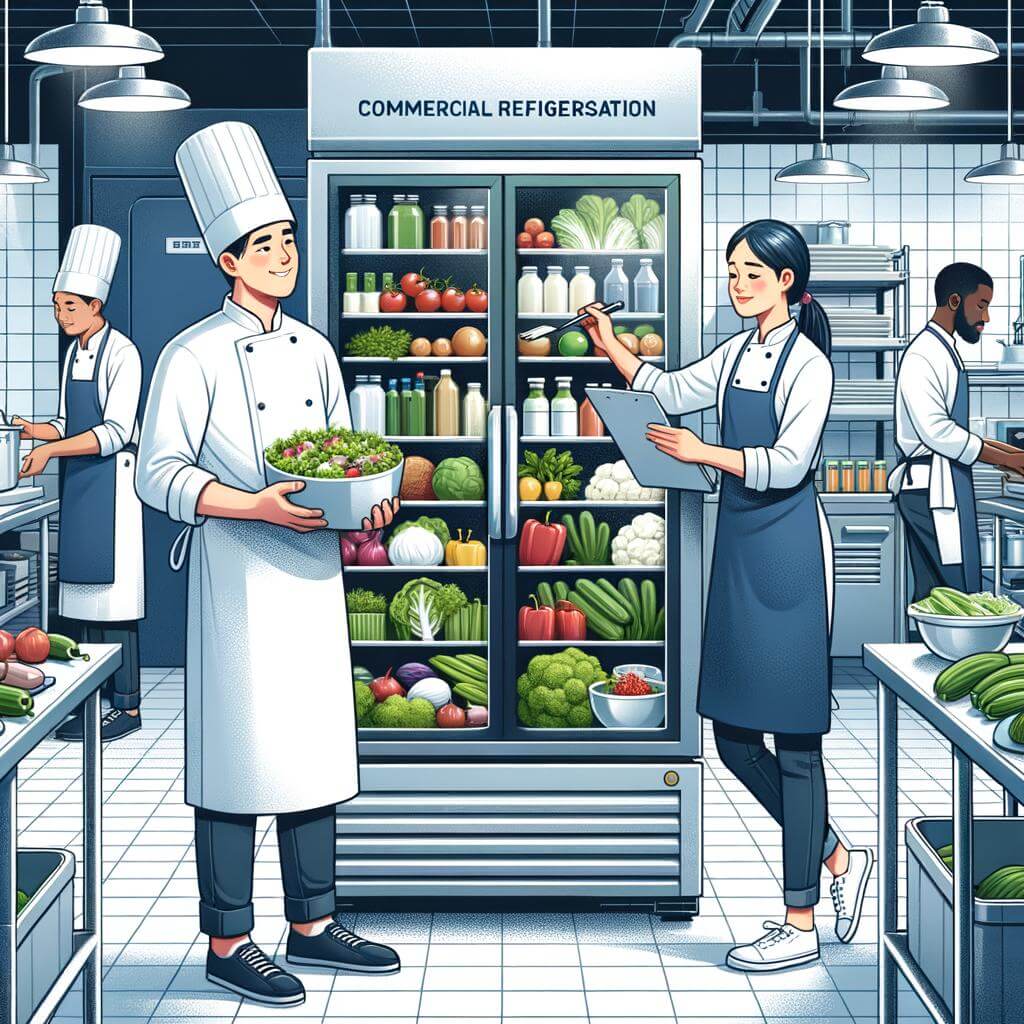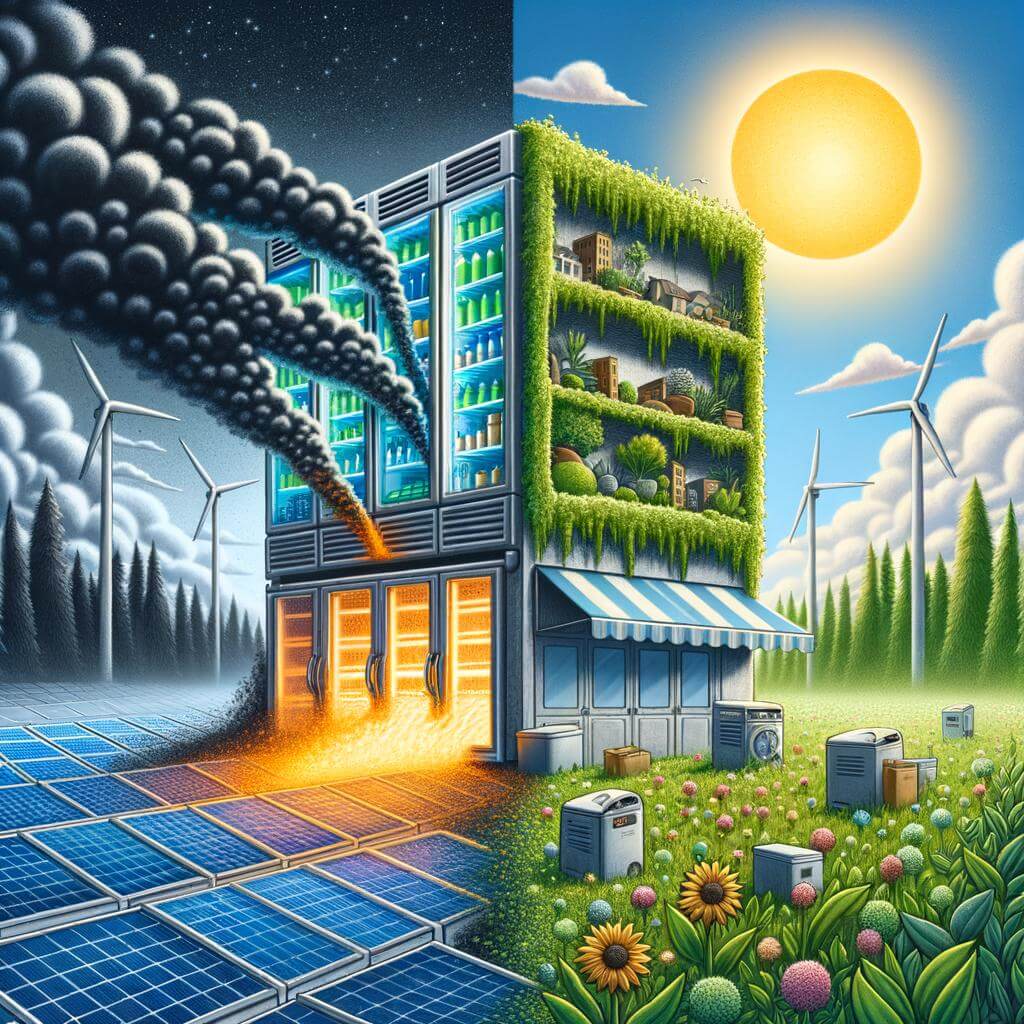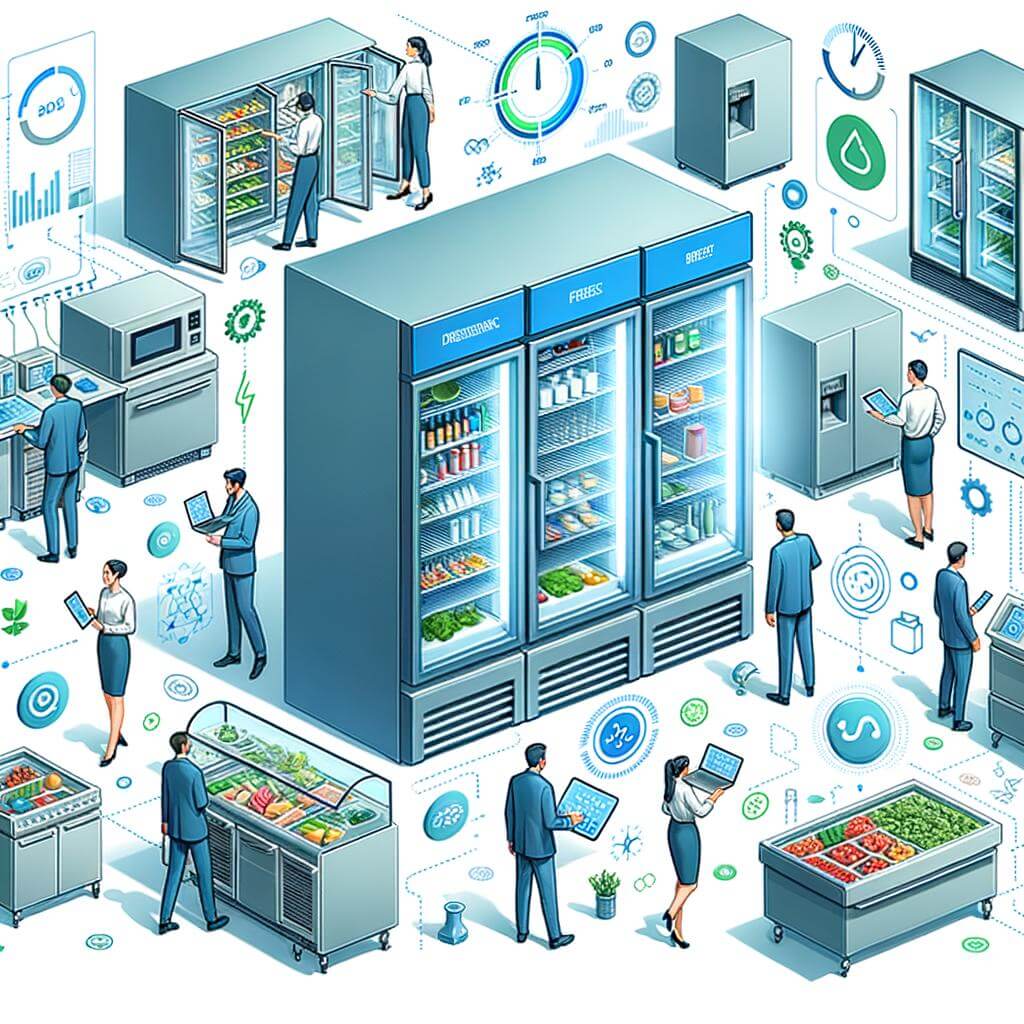Welcome to our in-depth exploration post on the fascinating topic of Commercial Refrigeration. This comprehensive article covers not just the intriguing history but also the anticipated future of this indispensable technology. Whether you’re a business owner seeking to understand how refrigeration impacts your operations, a history enthusiast, or just a curious reader, this post will provide a wealth of useful information. It is rich with expert insights, fact-based data, and educational content designed to give you a clear understanding of commercial refrigeration’s past development and future trends. You’ll find the knowledge acquired from this post can even help make more informed decisions related to your commercial cooling needs. So, let’s dive in!
Understanding the Evolution of Commercial Refrigeration
Delving into Commercial Refrigeration’s Humble Beginnings
Commercial refrigeration has made significant strides in the last century and half. The first refrigerator was introduced by Alexander Catlin Twining in 1856 in states. His ingenious invention revolutionised the way people preserved food. Later patented in 1867, this novel contraption ran on compressed air, and while it was commendably innovative for its time, it was greatly lacking in efficiency. Twining’s concept was picked up and reworked by various institutes and inventors over the years, leading to a wide array of improvements and variations:
- In 1913, Fred W. Wolf introduced the first electrically powered domestic fridge known as ‘Domelre’
- During the 1920-30s, refrigerators had started to become more mainstream as household items
- The 1940s saw the advent of Freon, a more efficient and safer refrigerant, which has since been phased out due to its impact on the ozone layer
Modern-day Advancements and Prospects of Commercial Refrigeration
Today, commercial refrigeration has become a vital part of countless industries – from food service and healthcare to retail and beyond. Advancements in technology have resulted in more energy-efficient, environmentally friendly, and user-friendly refrigeration systems.
| Year | Innovation |
|---|---|
| 1950s | Introduction of frost-free refrigerators |
| 1970s | Energy crisis led to research and development in energy-efficient refrigerators |
| 2000s | Rise of smart refrigeration technology |
The future of commercial refrigeration promises further improvements in energy efficiency, waste reduction, eco-friendly refrigerants, and better temperature control. As the world prioritizes sustainability, manufacturers are shifting focus towards developing models that can meet these demands while meeting industry-standard requirements.
Technological Advancements Redefining Commercial Refrigeration
As technology continues to evolve at a rapid pace, the commercial refrigeration industry is benefitting from new advancements and innovations. This isn’t just about keeping your beverages and perishables at the right temperature anymore, it’s about improving efficiency, reducing energy consumption, and offering enhanced features and functionalities. One such revolutionizing technology is the Internet of Things (IoT). IoT enables the integration of advanced sensors and intelligent systems into refrigeration units, allowing real-time monitoring and optimal control of temperature, humidity, and energy consumption. This not only saves money by preventing wastage and spoilage but also significantly increases operational efficiency.
Another milestone in the world of commercial refrigeration technology is the advent of CO2 refrigeration systems. As the world is becoming increasingly aware of the need for sustainable practices, CO2 refrigeration systems respond to this call with their low Global Warming Potential (GWP) and improved energy efficiency. Other game-changing trends include solar-powered refrigeration and magnetic refrigeration. Solar-powered refrigeration harnesses renewable energy for operation, reducing dependency on non-renewable resources. On the other hand, magnetic refrigeration is a cooling technology that’s not only more effective but also more energy-efficient and environmentally friendly than conventional methods.

The Role of Commercial Refrigeration in Today’s Food Industry
The food industry, heavily reliant on commercial refrigeration, has benefited significantly from its advancements. At its core, this technology has allowed for enhanced food safety, increased spatial efficiency, and improved product quality. Commercial refrigeration has revolutionized aspects like raw food preservation, due to its ability to drastically slow bacterial growth and maintain nutritional goodness. Moreover, it facilitates organized and efficient display of perishables in grocery stores, enhances the dining experience in restaurants through chilled beverages, and offers an ideal solution for bulk storage in warehouses or food processing factories.
Looking into the future, innovations in commercial refrigeration are aimed at increasing energy efficiency and adopting green technologies. These objectives reflect the global concern for environmental preservation and the need to limit carbon emissions, while not compromising on food safety and quality.
- Energy Efficient Systems: Technological advancements have led to the creation of more energy-efficient refrigeration systems. These systems use up to 40% less power than older designs, contributing to their growing popularity among business owners.
- Solar Power Refrigeration: To mitigate the environmental impact of traditional refrigeration methods, some companies are exploring the viability of solar-powered units. This approach harnesses the power of the sun to cool storage spaces, providing a clean, renewable source of energy.
- Natural Refrigerants: A significant trend in global commercial refrigeration centers on the use of natural refrigerants such as carbon dioxide and ammonia. This is an environmentally-friendly alternative to the synthetic refrigerants, significantly reducing the environmental footprints.
| Technology | Advantages |
| Solar Power Refrigeration | Uses clean, renewable energy |
| Natural Refrigerants | Environmentally-friendly, reduces carbon footprint |
| Energy Efficient Systems | Reduces power consumption |
Through these innovative measures, commercial refrigeration is setting the stage for a future food industry that not only delivers quality and safety but is also eco-responsible.

Environmental Impact of Commercial Refrigeration and Mitigation Strategies
Despite its crucial role in preserving perishables in the retail food industry, commercial refrigeration is also known to negatively impact the environment. This is due to the fact that these refrigerating systems tend to consume high amounts of energy, leading to increased carbon emissions. Furthermore, refrigerant leaks from commercial refrigeration units are a significant contributor to global warming. The use of outdated refrigerant gases such as Hydrofluorocarbons (HFCs), which are notorious for their high Global Warming Potential (GWP) exacerbates the issue.
However, there are various effective strategies for mitigating this environmental impact. Improving the energy efficiency of commercial refrigeration systems is a key strategy. This can be achieved through methods such as maintaining equipment properly, retrofitting older systems with more efficient components, and implementing advanced control strategies. Another crucial strategy is switching to natural refrigerants that have lower GWP such as ammonia, hydrocarbons, and Carbon Dioxide (CO2). Here’s a brief comparison:
| Refrigerant Type | Global Warming Potential | Potential Environmental Impact |
|---|---|---|
| Hydrofluorocarbons (HFCs) | High | Significant |
| Ammonia | 0 | None |
| Hydrocarbons | 3 | Low |
| Carbon Dioxide (CO2) | 1 | Low |
In conclusion, while commercial refrigeration does have an environmental impact, there are viable strategies for retail food businesses to reduce this impact. Through consistent effort, the industry can achieve sustainability while simultaneously advancing the quality of their refrigeration systems.

Current Trends in Commercial Refrigeration: A Look towards the Future
As we take a step into the future, commercial refrigeration is showing no signs of stagnating, with the industry continuously evolving to adhere to various new trends. Among them, energy efficiency stands as a towering trend, sparked by increasing awareness about climate change and the pressing need for sustainable practices. Old, energy-consuming models of refrigeration units are being rapidly replaced by environment-friendly, energy-saving models. The usage of advanced technology such as IoT (Internet of Things) is also gaining momentum, enabling real-time tracking of temperature, humidity, and other crucial parameters, thereby adding to energy efficiency and reducing waste.
Another noteworthy trend is the rise in demand for customizable refrigeration units. Retailers are looking to optimize space and showcase products in the most appealing manner, which is driving them towards tailor-made commercial refrigerators. Furthermore, an increasing emphasis on food safety regulations has spurred the trend for smart refrigeration. These smart units can automatically adjust temperature as per the load, send alerts for power failures or temperature variations, reducing the risk of food spoilage. Let’s take a quick look at these trends:
“`html
| Trend | Description |
|---|---|
| Energy Efficiency | Modern refrigeration units with low power consumption and higher performance. |
| Usage of IoT | Integration of IoT for real-time tracking and monitoring to enhance efficiency. |
| Customizable Units | Tailor-made to suit individual business needs, optimize space and display products. |
| Smart Refrigeration | Automated temperature control, alerts for power failures or temperature variation, reducing spoilage risks. |
“`
Embracing these rising trends can majorly impact your business’ bottom line, while also benefiting the environment. As the years roll on, we can expect more advancements and shifts in the commercial refrigeration landscape, which are sure to make energy management and food preservation more streamlined and efficient than ever before.

Best Practices for Adopting Next-Generation Commercial Refrigeration Technologies
In the journey to adopting next-generation commercial refrigeration technologies, a good number of key considerations come into play. Efficiency, cost-effectiveness, and environmental safety are among the few topmost criteria. It is vital to understand that while these new technologies boast higher performance levels, they must be properly integrated to get maximum results. As you set out to adopt these new commercial refrigeration technologies, there are a couple of best practices to keep in mind:
- Know your Needs: It is fundamental to properly identify your unique refrigeration needs. Knowing your exact storage requirements and preferred temperature ranges is key in getting the right system.
- Energy Efficiency: Advanced technologies often mean more efficient systems. Always opt for units with high energy star ratings as they consume less power and are more cost-effective in the long run.
- Proper Maintenance: Regular maintenance extends the system lifespan and ensures it operates optimally. Cleanliness, regular temperature checks, and prompt repairs are recommended.
- Environmental Responsibility: Refrigeration technologies that utilise natural refrigerants such as CO2 and ammonia help reduce greenhouse gas emissions. Selecting such systems contributes towards climate change mitigation.
>> When installing your new system, consider seeking professional assistance. Professionals can provide tailor-made solutions that fit your business’ specific needs. They can also guide you through proper setup and maintenance procedures. In line with this, the following table summarises some tips for effective selection of your commercial refrigeration system:
| Consideration | Tip |
| Size and capacity | Measure your available space and storage needs, choose a model that fits. |
| Energy efficiency | Look for energy star ratings, the higher the better. |
| Cost | Consider the long-term operating cost, not only the initial purchase price. |
| Eco-friendliness | Opt for units that use natural refrigerants. |
Remember, the goal is to incorporate a system that not only meets your business needs but also makes a positive contribution to the environment. So make your move today and lead the way in next-generation refrigeration! In conclusion, it is clear that commercial refrigeration has significantly evolved over the years, shaping industries, economies and our daily lives. However, what lies ahead is even more exciting. With technological advancements, a focus on sustainability and the growing demand for energy efficiency, the commercial refrigeration landscape promises to become more innovative, eco-friendly, and efficient. As we have explored the past, present and future of commercial refrigeration, we hope to have equipped you with a richer understanding of this indispensable field. It is also our hope that this knowledge will help you make informed decisions and choices revolving around commercial refrigeration in your business or daily life. Remember, the importance of commercial refrigeration extends far beyond keeping your food cold. It is an essential segment of the global economy, affecting the retail, medical, and food industries and many more. As we move forward, keep your eyes on the future of commercial refrigeration, because where it goes, so does a significant aspect of modern civilization. Stay informed, stay engaged and most importantly, stay cool.




